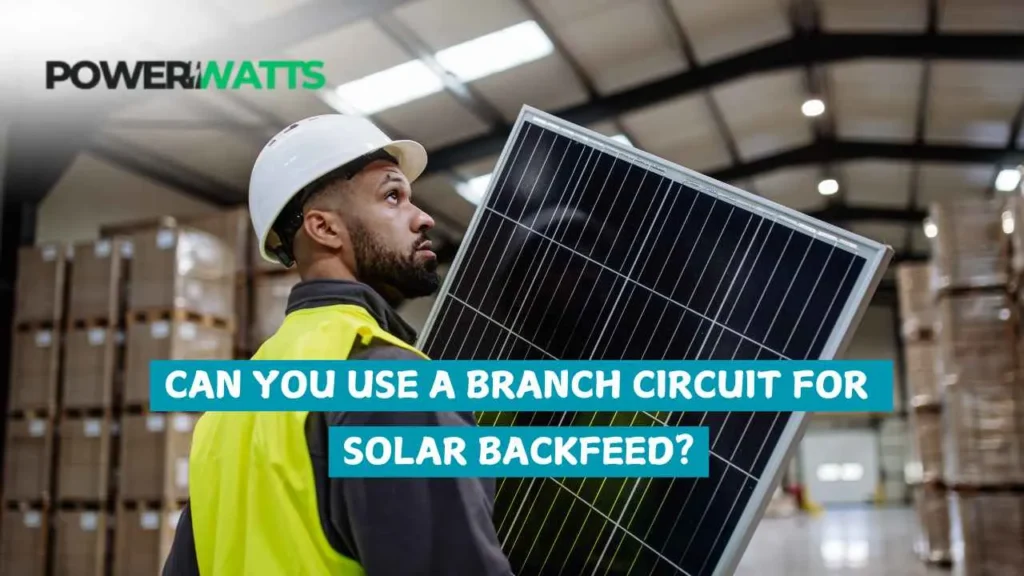One important thing about when thinking about adding solar energy systems to homes or businesses is the idea of solar backfeed. In this process, solar panels send back into the power grid any extra electricity they make. People often ask if they can use a branch circuit for solar backfeed. To make sure that safety standards and electricity rules are followed, it is important to know what this practice means. This blog post will go into more detail about whether can you use a branch circuit for solar backfeed, the benefits, and safety concerns.
Understanding Solar Backfeed
When a solar power system makes more electricity than is used on-site, the extra energy can run back into the power line. This is called solar backfeed. A backfeed switch, which is built into the main electrical panel, makes this process easier. The back feed breaker is an important safety feature that keeps power from flowing back into the grid during blackouts. This keeps utility workers from getting electrocuted.
Can You Use a Branch Circuit for Solar Backfeed?
It is possible to use a branch circuit for solar backfeed, but you need to follow certain rules and standards. These rules are in the National Electrical Code (NEC) and are meant to make sure that solar systems are safe and work properly.
- Setting up the breakers: The grid input breaker goes at one end of the breaker panel, and the backfeed breaker goes at the other end. This setup makes sure that the solar power gets to the screen in the right way.
- Type of Breaker: The NEC says that plug-in type backfed circuit breakers that are linked to the output of a stand-alone generator must be properly protected. Breakers with the words “line” and “load” on them should not be used for backfeed and should be avoided.
- Size of Breaker: The backfeed breaker needs to be the right size to handle the solar system’s full output. This site is very important to keep things from overloading and to make sure they work safely.
- Needs for Grounding: It is very important that the solar system is properly grounded so that both the system and the utility workers are safe. Grounding must meet NEC standards and any state rules.
Advantages of Using a Branch Circuit for Solar Backfeed
There are several reasons why using a branch circuit for solar backfeed can be helpful:
- Efficient use of money: When compared to adding a specialized backfeed breaker, using an existing branch circuit can lower the cost of installation.
- Installation that is easy: Connecting to a branch circuit may make installation easier because it may need fewer parts and less wire.
- Flexibility: This method gives system designers more freedom because it can work with different plans and setups.
Safety Considerations for Solar Backfeed
Even though it can be helpful to use a branch circuit for solar backfeed, it is very important to think about safety:
- Risk of Backfeed: If systems aren’t set up correctly, backfeed can happen into the grid during blackouts, which can be dangerous for utility workers. It is very important to make sure that the backfeed breaker works right and turns off the solar system when it needs to.
- Following the rules: To make sure the solar system is safe and reliable, it is important to follow the NEC standards and state codes. Inspections and upkeep should be done on a regular basis to ensure compliance.
- Proper Grounding: To keep electrical dangers from happening, grounding must be done properly. As stated in NEC guidelines, this includes using the right grounding methods.
Installation Process for a Backfeed Breaker
Here is a general outline of how to build a branch circuit for solar backfeed if you decide to go ahead with it:
- Setting up: Look at the current electrical system to figure out where the backfeed breaker should go. Always check to see if the breaker panel can handle the extra load.
- Picking Out the Breaker: It is important to pick a backfeed breaker that works with your solar generator and meets NEC standards.
- Putting in the Breaker: Place the backfeed breaker in the breaker panel where it’s supposed to go, making sure it’s securely in place and at the other end from the grid input breaker.
- Putting the Solar System together: Make sure all of the connections are safe and up to NEC standards as you run the wires from the solar generator to the backfeed breaker.
- Checking out the system: After setting up the system, it should be tested carefully to make sure it works right and is safe. This includes making sure that the backfeed stop works right when the power goes out.
Conclusion
Finally, branch circuits for solar backfeed may be used to integrate solar energy systems into existing electrical infrastructures. Homeowners and installers may use solar energy safely and reliably by knowing breaker setup, size, and grounding.
Safe solar installation methods are crucial as we switch to renewable energy. You can power your house with clean energy and help the environment by investing in solar technology. Contact us to improve your solar installation’s efficiency and safety. Our expertise can help you understand solar energy systems and make choices that benefit your house and the environment.


